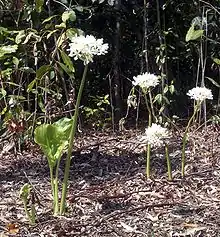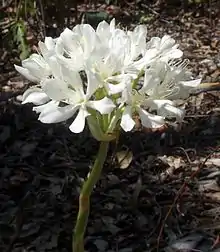Proiphys amboinensis
Proiphys amboinensis (syn. Eurycles amboinensis) was named after the island of Ambiona, now Ambon, in Indonesia. Common names include Cardwell lily and northern Christmas lily (as it usually flowers around Christmas). It is considered native to Thailand, Indonesia (Maluku, Sulawesi, Bali, Lombok, Timor), the Philippines, the Bismark Archipelago, Vanuatu, New Guinea, Queensland and Western Australia. Is also naturalized in Seychelles, Sri Lanka, Solomon Islands, Niue, Society Islands, Caroline Islands and Mariana Islands.[2][3]
| Cardwell lily Northern Christmas lily | |
|---|---|
 | |
| Proiphys amboinensis in Cooktown Queensland | |
| Scientific classification | |
| Kingdom: | Plantae |
| Clade: | Tracheophytes |
| Clade: | Angiosperms |
| Clade: | Monocots |
| Order: | Asparagales |
| Family: | Amaryllidaceae |
| Subfamily: | Amaryllidoideae |
| Genus: | Proiphys |
| Species: | P. amboinensis |
| Binomial name | |
| Proiphys amboinensis (L.) Herb. | |
| Synonyms[1] | |
| |
Description
Proiphys amboinensis produces nearly circular leaves followed by attractive scented white flowers with yellow throats. The larger leaves can be over 25 cm long have a leaf stem up to 46 cm long. The pure white flowers are 5 cm wide each with up to 18 flowers in a cluster on stalks over 50 cm. long. Flowering typically begins in late December and is followed by the production of green to blackish capsules 25–30 mm across. The leaves die away in the dry season.[4][5][6][7][8][9]
Cultivation and uses
Proiphys amboinensis prefers open, lightly shaded rainforest. It grows quickly after the arrival of the wet season The plant prefers a fairly well shaded position. A good container plant. Needs much water in the growing season. Propagate from seed or lift the bulb.[10]

References
- The Plant List
- Kew World Checklist of Selected Plant Families
- Fay, Michael F. and Mark W. Chase. 1996. Resurrection of Themidaceae for the Brodiaea alliance, and Recircumscription of Alliaceae, Amaryllidaceae and Agapanthoideae. Taxon 45 (3):441-451.
- Beasley, John. 2006. Plants of Tropical North Queensland: the Compact Guide. Footloose Publications, Kuranda. ISBN 1-876617-13-6.
- Herbert, William. 1821. Appendix 42, Proiphys amboinensis
- Linnaeus, Carl von. 1753, Species Plantarum 1: 291. Pancratium amboinense
- Rafinesque, Constantine Samuel. 1833. Atlantic Journal, and Friend of Knowledge, Philadelphia 165, Stemonix nervosus
- Australian National Botanic Gardens and Centre for Australian National Biodiversity Research, The genus Proiphus
- Atlas of Living Australia, Proiphys amboinensis (L.) Herb.
- Scarth-Johnson, Vera. 2000. National Treasures: Flowering Plants of Cooktown and Northern Australia. Vera Scarth-Johnson Gallery Association. ISBN 0-646-39726-5 (pbk.) ISBN 0-646-39725-7 Limited Edition - Leather Bound.